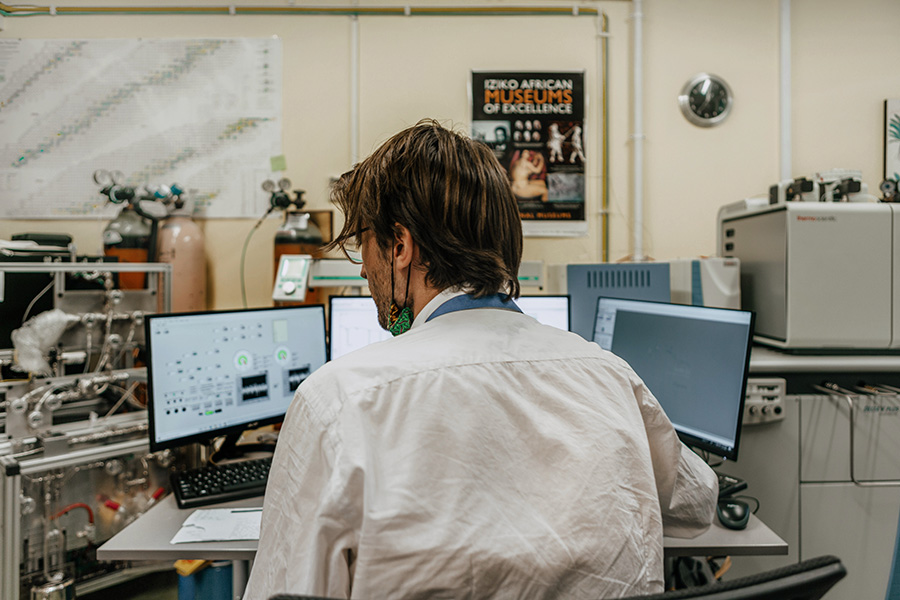This Stable Light Isotope Laboratory is equipped to measure stable (non-radioactive) isotopes of light elements carbon, nitrogen, oxygen, hydrogen, and sulphur.
These are the key elements in biological systems, and naturally occurring variations in their isotope ratios enable us to trace processes within those systems such as what eats what in a food-web, and how to reconstruct ancient human diets.
These isotope ratios also vary according to the environment, so analysing archaeological items like bones, teeth, shells, and plant remains enables us to reconstruct the environments in which past humans lived.
Early work in this lab in the 1970s led to the first-ever paper using stable isotope ratios as a dietary tracer, to track the spread of maize agriculture in eastern North America. This has now become a major field of study in archaeology, biology, and ecology among others.
Archaeological projects at the Stable Light Isotope Laboratory focus on past environments and human diets in South Africa over very long timescales. We are also helping to develop new techniques, such as applications of the rare isotope oxygen 17.
The Stable Light Isotope Laboratory forms part of the national Biogeochemistry Research Infrastructure Platform (BIOGRIP) developed by the Department of Science and Innovation (DSI) as part of the South African Research Infrastructure Roadmap (SARIR). Researchers from a wide range of disciplines in the life and earth sciences make use of this laboratory.

Staff at the Stable Light Isotope Laboratory
Students at the laboratory:
- Patricia Groenewald (PhD)
- Nandi Masemula (PhD)
- Hope Chakanetsa (MPhil)
- Malefeu Lethuba (MSc)
- Gemma Poretti (MSc)
- Drake Yarian (MSc)
- Gina Beyers (Honours)
- Amy Cunningham (Honours)
Selected publications:
de Flamingh, A., Coutu, A., Sealy, J., Chirikure, S., Bastos, A.D.S., Libanda-Mubusisi, N.M., Malhi, R.S. & Roca, A.L. 2021. Ancient DNA and isotope analyses establish provenance of ivory from a 16th century shipwreck. Current Biology 31(3):621-628. https://doi.org/ 10.1016/j.cub.2020.10.086
Hare, V.J. & Lavergne, A. 2021. Differences in carbon isotope discrimination between angiosperm and gymnosperm woody plants, and their geological significance. Geochimica et Cosmochimica Acta 300: 215-230. https://doi.org/10.1016/j.gca.2021.02.029
Sealy, J., Naidoo, N., Hare, V., Brunton, S. & Faith, J.T. 2020. Climate and ecology of the palaeo-Agulhas Plain from stable carbon and oxygen isotopes in bovid tooth enamel from Nelson Bay Cave, South Africa. Quaternary Science Reviews 235: 105974 https://doi.org/ 10.1016/j.quascirev.2019.105974
Luyt, J., Hare, V.J. & Sealy, J. 2019. The relationship of ungulate δ13C and environment in the temperate biome of southern Africa, and its palaeoclimatic application. Palaeogeography, Palaeoclimatology, Palaeoecology 514: 282-291. https/doi.org/ 10.1016/j.palaeo.2018.10.016
Dlamini, N., Morris, A.G. & Sealy, J. 2016. Carbon isotopes and dental caries as evidence for regional variation in the diets of early farming communities from Katanga, Democratic Republic of the Congo. Journal of African Archaeology 14(2): 135-153.
Contact:
Dr Julie Luyt
Archaeology Department
Beattie Building, Rooms 3.23 and 3.24
Dr Julie Luyt
julie.luyt@uct.ac.za


